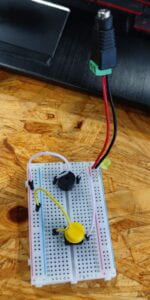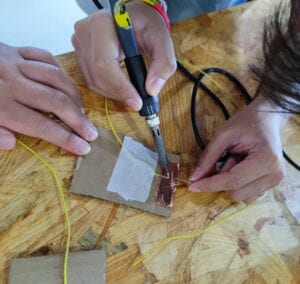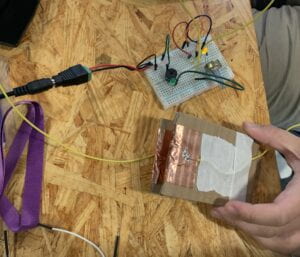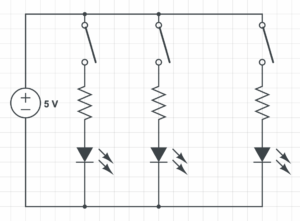Task 1: Build the Circuit
Step 1:
Step 1 consisted of creating a circuit with a buzzer and button. Jack and I had a lot of difficulty initially since we didn’t know what parts of the bread board were connected in the back. After some help and multiple trials, we were able to make the circuit work.

Step 2:
In Step 2, we had to add an LED to the circuit, which would light up when the button would be pressed. We didn’t have any trouble implementing the LED since we understood how to read the circuit diagram.
Step 3:
For Step 3, we had to add a variable resistor and another LED. The LED’s brightness should be controlled by the variable resistor. We had a bit of trouble with the variable resistor since we didn’t know if we had to connect the wire to the variable resistor from the middle or the side. After additional trial and error, we were able to get it to work.
Task 2: Build a Switch
In Task 2, we had to build a switch using cardboard, copper tape, and wires. We first cut some wire and cut the insulator at the end of the wires. Then we taped it to the cardboard, and we also covered one end of the cardboard with copper tape. Next we soldered the wire and the copper tape together. It was really fun soldering since it was my first time.
Initially I kept heating the wire but nothing happened, but afterwards I used the metal wire and it melted instantly. I used the liquid metal to solder the wire and copper tape together.

Task 3: Switch the Switches
In Task 3, we replaced the button with the DIY Paddle that we created. Jack and I did it very quickly since we had good coordination and communication. When the copper ends of the DIY Paddle touched each other, it would trigger the LEDs and buzzer. It was so cool!

Additional Required Questions:
Question 1: The function of the R1 resistor is to control the current that passes into the LED.
Question 2:

Question 3: The circuit that I built includes interactivity since it possesses the Listening aspect of interactivity. When the button/DIY Paddle is pressed it creates a noise, which can be represent morse code. The other actor must listen and interact with the noise to understand what is being communicated.
Question 4: Physical Computing gives tools to artists and designers who design products to create art that is interactive. Zack Lieberman’s video uses tracking software on cars to create artwork through the movement of the car.